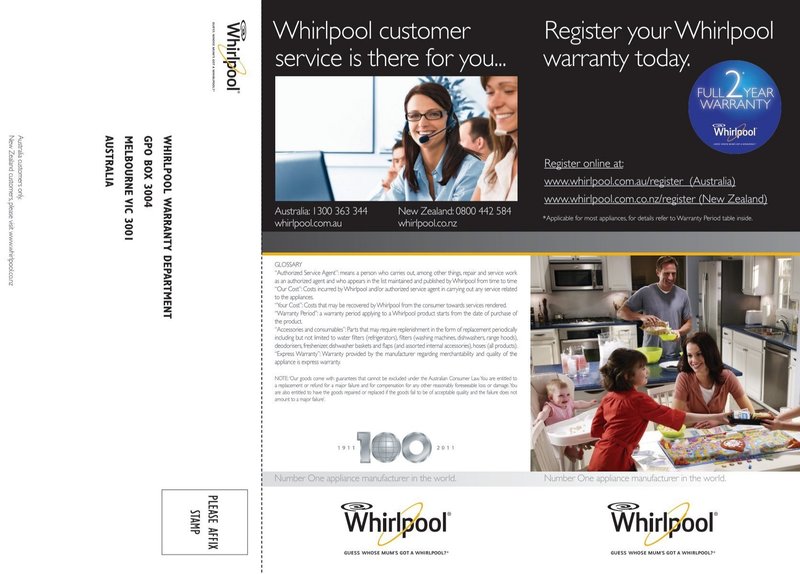
Think of warranty registration as adding your new gadget to a VIP guest list. You technically have the ticket (your receipt and the warranty itself), but does RSVPing in advance mean you’ll get better treatment when something breaks? Let’s grab a cup of coffee and break this down in plain English—no legal jargon, no marketing fluff, just the real story behind registering your Whirlpool appliance and what it actually does for your service experience.
What Is Warranty Registration For Whirlpool Appliances?
Let me explain what we’re really talking about when we say “warranty registration.” When you buy a Whirlpool appliance—maybe a shiny new stove, a dishwasher, or one of those refrigerators that looks like it belongs on a cooking show—it comes with a **manufacturer warranty**. This warranty says Whirlpool will fix or replace certain problems for free, usually for a set period of time.
Registering the warranty just means you’re telling Whirlpool, “Hey, I bought this, here’s when, here’s where, and here’s some info about me and my new appliance.” It often involves filling out a quick online form or mailing in a card. You’ll enter your appliances’ model and serial numbers, the date of purchase, maybe even the store where you got it. No tech wizardry needed—just some basic details.
But here’s the thing: *your warranty is valid even if you never register.* The law says as long as you’ve got your proof of purchase, you’re covered. So why does Whirlpool (and, honestly, almost every other brand) encourage you to register? That’s where things get interesting—and sometimes a little confusing.
Does Registering Your Warranty Actually Improve Service Response?
You might be wondering if taking the time to register your Whirlpool appliance really matters when something goes haywire. The honest answer? **It helps smooth things out—but it’s not a magical fast pass.** Here’s how it works in practice.
When you reach out to Whirlpool customer service for troubleshooting, repair, or warranty claims, having your appliance already registered makes it easier for them to pull up your info. They don’t have to spend extra time verifying your purchase or figuring out if your model is covered. Think of it like checking in online before a flight: you still have to wait in line, but the paperwork’s already done.
Bottom line:
- If your appliance is registered, Whirlpool can often look up your details—saving you from hunting for receipts, serial numbers, or other proof.
- If you didn’t register, that’s okay, but prepare to show your proof of purchase and maybe answer a few more questions when requesting service.
It’s faster and less stressful for both sides if your info is already in their system. But, *and this is important*, registering doesn’t mean you leapfrog to the front of the repair queue. It just makes the process less painful when you do need help.
Why Whirlpool (And Other Brands) Want You To Register
Let’s pull back the curtain a bit. Why is Whirlpool so eager for you to register that they leave cards in the box and reminders in your inbox? Well, it’s not just about helping you—there’s something in it for them, too.
When you register a product, Whirlpool gets valuable data:
- Which models are popular (and where they’re sold)
- How appliances perform over time
- How quickly issues pop up in certain regions or situations
This info helps the company improve future models, track recalls, and even tailor their customer service. If there’s ever a recall or a really common problem (like a certain dishwasher model that keeps showing a reset code), they can actually reach out to folks who registered. That means you might get notified about fixes or updates sooner if you’re in their database.
On your end, though, the big benefit is that registration **simplifies troubleshooting**. Whirlpool might offer tips, maintenance reminders, or even special offers—sometimes, if you registered, you get updates that make syncing with repair techs or ordering parts a little easier.
How Whirlpool Handles Warranty Claims (With And Without Registration)
So what happens, step by step, if your carefully paired Whirlpool appliance decides to throw a tantrum? Here’s how the warranty service experience usually goes, whether you registered ahead of time or not.
If you *did* register:
- Whirlpool has your appliance’s details ready to go—model, serial, date purchased, and maybe even where you bought it.
- When you call or start a claim online, they can quickly check if your warranty is active.
- This means less time spent digging through kitchen drawers for that crumpled receipt or trying to read a faded sticker on the back of your fridge.
If you *didn’t* register:
- You’ll need to provide proof of purchase and appliance info at the time of your claim.
- Sometimes, this might slow things down a little, especially if you’re missing the right paperwork.
- But Whirlpool still has to honor the warranty as long as you can prove your purchase and the issue matches their policy.
In my experience, registered appliances just mean fewer headaches when something breaks. You don’t get *special* treatment, but you do avoid the classic wild goose chase for paperwork and model numbers.
What About Universal Warranty Services Or Third-Party Repair?
Here’s a curveball: what if you’re using a universal warranty company or a third-party repair service—maybe the local repair shop in town or a big-box chain’s coverage? In those cases, Whirlpool’s official registration probably doesn’t make much difference. These companies run their own systems and may not have access to Whirlpool’s customer database at all.
You’ll need to follow their rules for proving coverage, which often means showing your receipt, warranty card, or a unique code that IDs your appliance. Registration with Whirlpool can’t hurt—and it might still help if there’s a recall or brand-specific troubleshooting update—but it’s rarely a game-changer outside Whirlpool’s own repair channels.
If you’re using universal services or extended warranties, make sure you:
- Keep your receipts in a safe, easy-to-find spot
- Know your appliance’s model and serial number
- Check if they require *their* own registration process
Common Frustrations: Codes, Delays, And Customer Service Runaround
Let’s be real—appliance problems are rarely convenient. If your Whirlpool oven suddenly stops syncing with the control panel, your panic probably won’t be soothed by knowing whether or not you registered. What gets people frustrated is the sense that they’re lost in a maze of codes, troubleshooting steps that never work, or endless phone menus.
Here’s what registration can and can’t do:
- It CAN: Make customer support calls quicker (they already have your info)
- It CAN: Help Whirlpool reach you if they discover a widespread issue or recall
- It CAN’T: Guarantee same-day service or jump you ahead in line
- It CAN’T: Fix the appliance for you or add extra warranty time
If you hit a snag with service response—say, multiple calls, repeated resets, or back-and-forth about battery replacement—having your warranty registered helps, but it won’t magically solve every customer service hiccup. Sometimes, it’s just about patience…and maybe a cup of tea while you wait for the repair tech to arrive.
How To Register (And Why It’s Worth The Two Minutes)
Honestly, if you’ve just unpacked your new Whirlpool appliance, it’s worth taking the two minutes to register it. Whirlpool makes it pretty straightforward and offers several ways to do it:
- Go online to the official Whirlpool product registration page
- Scan any QR code on the paperwork or packaging (it often takes you straight to the right webpage)
- Fill out and mail the old-school registration card (if that’s your thing)
You’ll need:
- The model and serial number (usually found on a plate or sticker inside the appliance door or on the back)
- The date and place you bought your appliance
- Your contact info
It’s not a marathon—more like a quick sync between you and Whirlpool’s records. Once it’s done, you’ll usually get a confirmation email, and you can rest easy knowing support will be a little bit simpler if you ever need help.
Registration isn’t about jumping the line; it’s about making sure your info is ready when you need it—because let’s face it, nobody wants to dig through paperwork when the fridge is melting.
The Real-World Difference: Does It Make Service Faster?
Here’s the million-dollar question: **does warranty registration make Whirlpool’s service actually faster in real, frustrating moments?** The answer is nuanced.
*Yes, in the sense that it streamlines everything.* When you call for help, there’s no “please hold while I look up your purchase history” nonsense. Your case opens quicker. The tech who comes to your house has the right info and the right parts.
*No, in the sense that everyone—registered or not—waits their turn for an available repair slot.* If there’s a backup due to high demand or parts are delayed, registration won’t wave a magic wand.
Still, most people who’ve dealt with major appliances agree: the less time you spend on the phone spelling out serial numbers or searching for receipts, the better. In that way, registration really can “improve service response” by cutting out administrative delays and smoothing the troubleshooting—or warranty claim—process.
Final Thoughts: Is Warranty Registration Worth It For Whirlpool Customers?
So, should you bother registering your Whirlpool kitchen appliance after you haul it in from the curb, peel off the plastic, and admire its gleaming buttons? My honest take: **Yes, it’s worth the quick effort.**
Registration won’t turn you into a VIP or guarantee a repair van at your door tomorrow. But it *does* make the service process less of a hassle if your appliance throws a curveball—whether that means faster access to help, less paperwork to wrangle, or getting recall alerts that could save you time and money down the road.
At the end of the day, warranty registration is like writing your name on your lunch in the fridge at work. It probably won’t stop every problem, but when something goes missing (or stops working), at least it’s clear who gets helped—without a messy argument or wild goose chase for proof.
So, if you’ve just bought a Whirlpool kitchen appliance, go ahead and register it. Worst case, you spend two minutes and never need it. Best case, you’ll thank yourself the next time you hear an odd beep, see a strange code, or just want service without the song and dance.
